By Robert Bruce
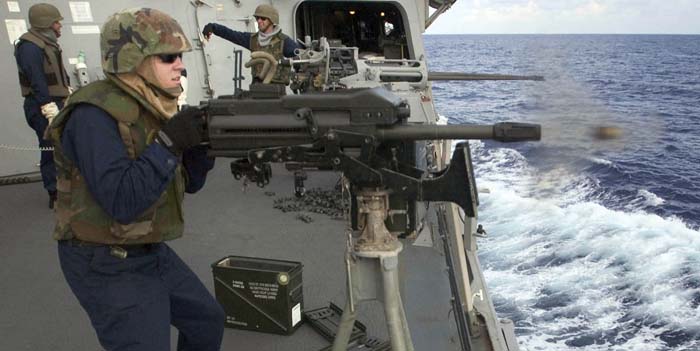
“My favorite is the .50 cal. The brainchild of John Browning is a beast of a weapon but it’s so simple and it’s been around for nearly a hundred years. That’s amazing to me. The M240 has quickly climbed that list. It seems like they took the M60 and said how can we simplify this and make it easier for the average guy to get behind this weapon and do well with it. And I think that’s what the 240’s turned into.” Petty Officer First Class Tim Caldwell, CSWI Course Student
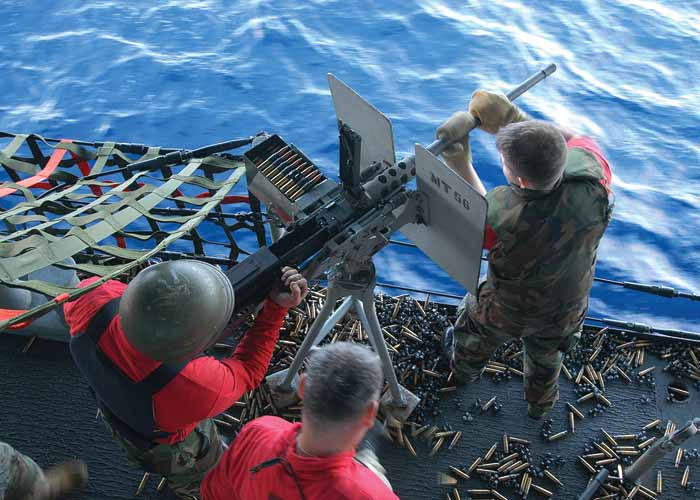
Range 14, MCB Quantico, VA – 15 March 2007
PO1 Caldwell, a straight talking 41 year old Master-at-Arms Navy Reservist, was responding to a question we like to ask gun guys everywhere we go. He answered without hesitation and few would dispute his observation about Browning’s .50 caliber masterpiece, prototyped in 1918 and still going strong today.
Further discussion followed, of course, and the seven year veteran, a police officer in civilian life, was intrigued to learn that the M240 of his growing esteem was a direct descendent of other Browning designs.
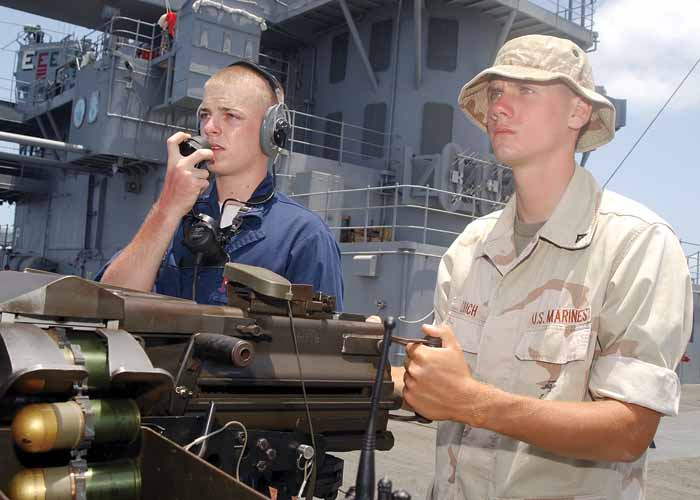
Rarely hesitant to conduct a short course in firearms history, we explained that it was born in Belgium in the late 1950s at Fabrique Nationale, European licensee for all of John Browning’s designs. The FN MAG 58’s boxy, riveted, heavy steel receiver is common to Browning’s .50 and .30 caliber machine guns and its operating and locking system are derived from the stalwart Browning Automatic Rifle, initially fielded in 1918, the last year of WWI. Now made in the US at FN Manufacturing, Inc. as the M240, the gun is essentially unchanged in form and function after a half century of service in many armed forces worldwide.
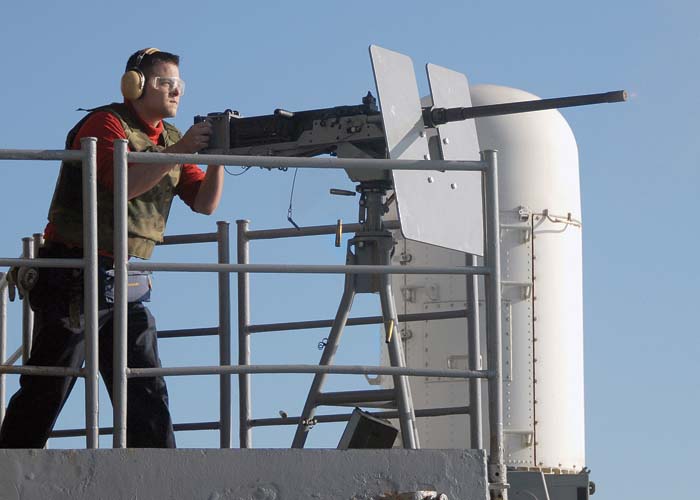
As to Caldwell’s observations on the combat utility of the stamped sheet metal receiver M60 (based on the WWII German MG42 with the operating system of the WWI Lewis Gun), its development began at the end of WWII and was adopted by the Army in 1957, making it a contemporary of the MAG 58. The “Sixty” entered service in the Marine Corps and Navy during the Vietnam War and has served with mixed reviews since. The Navy still has thousands in the fleet and ashore, including the significantly improved MK43 versions that were developed for Naval Special Operations, but intends to remove all 60s from first line use by the end of 2008.
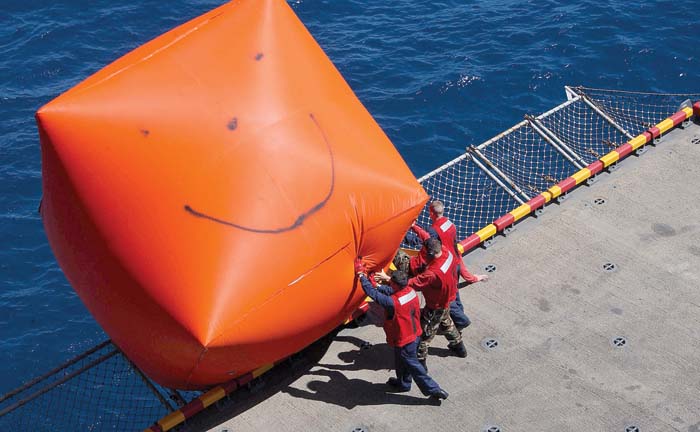
He explained that all the aging and hard-used M60s in his unit are scheduled for replacement as new M240s come into the Navy inventory. We certainly understand his preference for brand new Browning-inspired M240s over the worn and tired Sixties since reliability will undoubtedly be greater and the substantial weight penalty is not so big a factor in typical Navy Expeditionary Warfare operations.
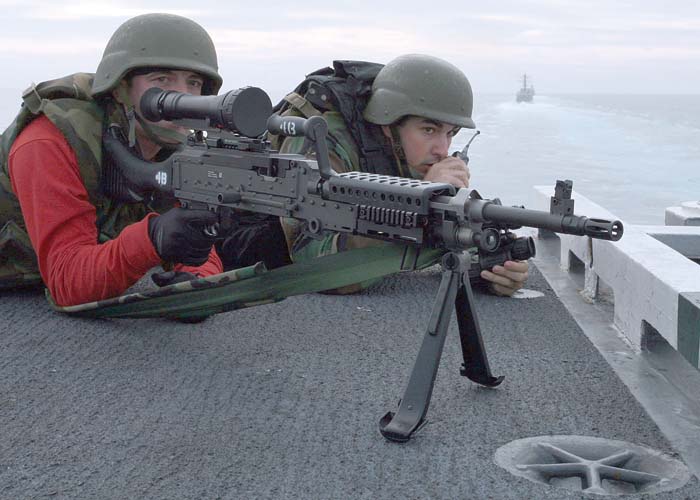
Meanwhile, he and his fellow students were getting plenty of training with both machine guns, an eminently practical solution during this time of transition Navy-wide.
Contract Training Package
It was Day 4 of Center for Security Forces’ intense and demanding two-week Program of Instruction (POI) that qualifies Navy personnel in the rate (rank is “rate” in the Navy) of E5 and above to teach their fellow Sailors the science and craft of effective employment of crew served weapons on land and sea. Caldwell and eleven other Petty Officers from various commands were a few hours into the first of two days on Quantico’s vast range complex.
Although the students were under the direct control and supervision of CSF’s military staff, we found it interesting that all the front-line instructors for this block were civilians, employees of Virginia Beach-based Special Tactical Services (STS), one of several firms contracted by CSF for various programs.
Make no mistake about their qualifications for the tasking, all of these guys are former military and most with more than one Global War on Terrorism (GWOT) deployment. Under the stern eye of STS Vice President Bill Witherspoon, a burly, retired Marine Gunnery Sergeant, six red-shirted STS employees were getting the job done with professionalism and efficiency.
Equally impressive was the fact that STS’ support package even included all the weapons to be used on both days, a tall order for any operation. Today’s emphasis was on live fire with the 7.62mm M60 and M240 machine guns, weapons in widespread use throughout the Navy. The following day would be hands-on with Caldwell’s esteemed .50 caliber M2HB and the 40mm MK 19 Mod 1, heavy hitters for serious situations.
Petty Officers Make It Happen
A short break in training action on the range yielded an opportunity to speak at some length with Chief Petty Officer Alex Hebert (pronounced “A-Bear”), Weapons Department Head at Center for Security Forces’ Chesapeake Learning Site. The serious but cordial 34 year old Master-at-Arms (Air Warfare) has 15 years in the Navy including service in Mobile Security Forces and 13 months in his current position at CSF.
Our Public Affairs escort for the day, Lieutenant Brian Simpson, CSF’s Assistant Expeditionary Warfare Program Manager, had spoken earlier of Hebert with high praise, “If I could clone him I’d be a happy camper.”
SAR: What’s the biggest challenge you and the other instructors have in implementing what we’re looking at today?
Hebert: Logistics. Currently, the Navy doesn’t own any of their own machine gun ranges in the Norfolk area. The closest Marine Corps range is Quantico, a three and a half hour drive from Norfolk. The closest Army range is a two and a half hour drive. Then you have to worry about lodging and food and ammo and getting the weapons up to the range. If we could do something to get a machine gun range in the Norfolk regional area, a closer range where we could shoot heavy machine guns on – Fifty Cals, Mark 19s – logistically it would make the job a lot easier.
SAR: Ammunition is sometimes in short supply due to wartime operational requirements and other factors. Have you got all the ammunition that you need for this course?
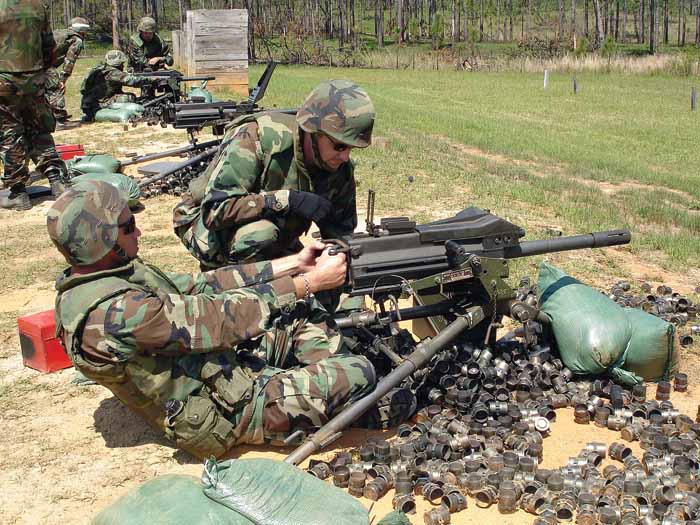
Hebert: Yes.
SAR: Is two weeks enough time to implement the CSWI program of instruction?
Hebert: Yes. With the two weeks you’re looking at ten to twelve hour days, so the instructors get a lot of what they need on the weapons. Most of these guys should be coming to us with some machine gun background so they should already have some knowledge of the weapons. Prior to that they have to complete the two week Operation and Maintenance course where they learn how the weapon actually operates, what that weapon does, all the intricacies of the weapon. So it’s actually four weeks of instruction.
SAR: We talked about how getting students out to a suitable live fire range is a long reach, but as far as the rest of the necessary components – classrooms, access to the FATS (Firearms Training System) simulator, these kinds of things – is that working well?
Hebert: Yes sir. On our Learning Site in Chesapeake, Virginia, we have two classrooms we can use plus a FATS room where we can fire up to twenty weapons at a time if we need to. Also, we have a blank fire range in the back of our compound, so after the students do the live fire component and FATS component they come to us.
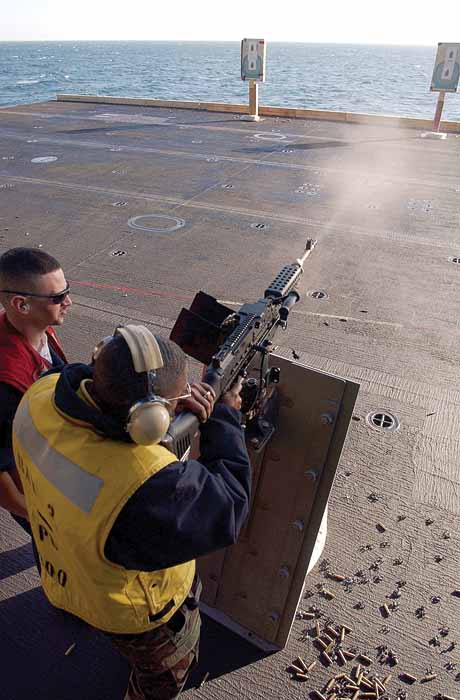
SAR: This course is “Train the Trainer.” Tell us about the process.
Hebert: We have a ‘crawl, walk, run’ method that we do with the students. When they first get to the school we start them with some PowerPoint’s on teaching fundamentals, how the weapons operate, principles of machine gun employment.
Then we bring them into the FATS simulator for the ‘crawl’ portion of it. They shoot this course of fire that they will shoot later in live fire. In the simulator we can correct any bad habits, we can look at things they’re doing, we can give them recommendations without actually having live bullets flying around. I can train all the 7.62mm weapons, the .50 caliber, the Mark 19, we can also do the Squad Automatic Weapon, 9mm pistol, shotgun, M203.
So we go from crawling on FATS, then we come up to Quantico. Currently we spend two days here but in the next two months we’re going to increase that to three days on the range. That’s where students are beginning to ‘walk,’ shooting live fire with machine guns on a full size range, seeing everything happening.
From there we go to the ‘run’ phase where instructors and students switch roles. It’s done in blank fire and we’ll run through the same exact drill sets they’re running through today. This time it’s their show, they’re running it and we’re the worst students in the world, giving them all kinds of headaches so they can know how to deal with a student who doesn’t know what he’s doing with the weapon.
SAR: Your CSWI students are Petty Officers – E5 and above – so they have an experience level they bring with them right now. Why is it important to have a more experienced Sailor who is then going to be a weapons instructor back in his unit?
Hebert: There are a few issues with that. First, it’s E5 and above in any rating (Military Occupational Specialty). Prior – probably about five years ago – the only personnel who could teach firearms in the Navy were your Aviation Ordnancemen, Gunners Mates, Torpedomen, and Master-at-Arms. Well, because the Navy has gone to more of a hybrid Sailor – on the Riverine Forces, Mobile Security Forces (MSF) – you have a wide array of different types of Sailors. You can have a Culinary Specialist (Cook) running a machine gun, so we decided to open it up. Anybody who can qualify on the weapon can become an instructor because of how we’re developing hybrid Sailors. The E5 portion, a lot of the ranges you sign out by Army or Marine Corps standards an E5 or above is the only one who can run the range – leadership ability, situational awareness, things like that.
SAR: We have seen some ‘tricks of the trade,’ things maybe not exactly by the manual. Comment on bringing real life experience into the program of instruction and making this work in a way that is acceptable to the higher headquarters.
Hebert: Every thing we do on the range is by the instruction manual. We don’t go outside the instruction. What we do is if we have a question on something we’re doing and whether or not we can do it, we’ll clear it through higher authority with the Navy. We’ll demonstrate it to them, talk about it and see what we can do. The last thing we want to do is something that’s not inside of the instruction because we’re training the trainer.
SAR: Is one example the Runaway Gun Drill?
Hebert: This is a surprise that has to be recognized and immediately fixed. Classroom instruction prepares them to deal with a runaway gun. So, the only thing different implemented here is that the instructors say, ‘We’re going to introduce you to the MK43 machine gun on a tripod mount. One volunteer get down behind it and everybody else gather around.’ Then all of a sudden the one student picked for the demonstration gets a surprise and has to deal with a runaway gun. That’s more of a dramatic presentation than what’s usual in a program of instruction.
Simpson: (Lieutenant Simpson joins the conversation) It’s required by the schoolhouse that they’re not allowed to take that technique back to the ship and do it in that kind of a (live fire) training situation. The schoolhouse does it as a demonstration to make the point that you’re never really ready when this happens to you.
SAR: But it’s perfectly OK that this is done because it’s a dramatic lesson the students will remember for a long, long time.
Simpson: That’s correct. Noted once again, specific situations have been routed and approved through our chain of command. But it’s a learning technique we don’t recommend for our CSWI graduates to take back to the ship. It’s not authorized for them to take this technique back to wherever they’re stationed.
SAR: Give us an example of a real world lesson that has been brought back and then incorporated in the program of instruction here.
Hebert: When our course was in its beginning stages a lot of our shooting was done from ground type mounts – tripods or bipods in fixed positions. One of the things we realized was we’re not just training Navy ground forces; we’re also training a lot of the Navy surface forces. And surface forces shoot from a standing position; they shoot from a shipboard mount. One of the things we did was to have a trailer developed and certified. The trailer actually simulates being on board ship with the mount at the same height, the same distance from lifelines. Sailors actually get up and shoot like they’re shooting from a ship. That was taken from the fleet and we brought it into the course. And they can also experience how their brothers on the other side of the Navy are shooting. So, your sea sailors are shooting like ground sailors and your ground sailors are shooting like sea sailors because you never know when a ship may have to do its landing party team and they may have to do a ground mount. Now, they’re being exposed to all aspects of the weapon and how it can be employed.
SAR: In shooting from the mounts on the trailer, is there anything specific that you learn as a result of that – brass splashing off the bulkhead, coming back at you and rolling around on the deck?
Hebert: No, it’s really straightforward; the brass falls down on the deck. You have some slip hazard from brass on the deck so you have to continuously police your brass. Whereas on a ship it would just be kicked overboard or fall overboard. On the trailer we just have to make sure to police the deck to keep the brass from being on the deck as a slip hazard.
SAR: If you could write the POI exactly as you wanted, would you make any changes?
Hebert: We’re doing revisions to it on a continuous basis trying to improve it. Some things we’re adding are to use M203s for target illumination during the night fire. We’ll teach the students how to instruct their shooters on different types of target illumination, how to employ the M203 effectively with the machine gun. Both using flares and using HEDP (High Explosive Dual Purpose) rounds for dead space where the machine guns can’t reach or can’t cover. You can lob that HEDP round into that hole and still have an effective machine gun position.
SAR: How about a Night Vision component?
Hebert: Yes there is. Once we implement the whole night shoot there will be a night vision component – in about two months from now. In the O&M phase, the prerequisite course, they learn about maintenance and use of the night vision goggles, how they work with your eyes, the physiology.
SAR: But as far as practical application with night vision on the guns, that’s not being done now but is planned for the future?
Hebert: Yes, that’s in the revision and probably will be done beginning two months from now. Night vision goggles and thermal imagers, night vision scopes, a multitude of NVO (Night Vision Observation) equipment. Also the flares.
That’s why we’re going to add that third range day. There will be a day of 7.62mm machine guns, then a day of M203 and 7.62, then a day of .50 cal.
Simpson: Just to clarify, we aren’t going to do any night qualification – just familiarization. It will be up to the unit to actually do the qualification at their level.
SAR: You have a dozen students. Are any in danger of not making it through?
Hebert: With an instructor course – because most of these students do have some machine gun experience – we ‘re not going to see the students who might fail until next week when they start doing their ‘teach-backs.’ When they start teaching us the weapon systems and they start teaching us the live fire portion that’s where we’re going to see our ‘problem children’ who won’t be able to make it through the course.
SAR: Based on your experience with the number of students coming through past courses, average number who don’t make it?
Hebert: One or two per class. The main reason is they can’t relay the knowledge they have to other people to learn it properly. Or just not as familiar with the weapons as they are expected to be.
SAR: So it’s not a gentleman’s course. If you can’t make the standards you aren’t going to graduate.
Hebert: We’ve dropped people on graduation day.
SAR: What remedial help do you give them?
Hebert: All of our instructors are available the entire class day, we open the doors at 0700 and we’re usually there until 1800. And during the entire day all the weapons and instructors are available for after hours work. The weapons are always at the back of the classroom. During a break if the students want to work with the weapons and do some practice, they verify everything’s safe and they can pull a weapon out – continuously work with a weapon and take the ‘bogeyman’ out of the weapon for themselves.
The other thing if a student is having problems, the first thing we’ll do is have a counseling session and explain to him where their problems and deficiencies are. That will usually be a one-on-one situation and we’ll work with it. If the student continues to have problems or if the student fails to meet a performance requirement then we’ll remediate that student on the performance requirement – on the test or on the live fire portion – explain to him where they’re failing and what they can do to make improvements. Then re-test on that portion of it. If they fail that, then we hold an Academic Review Board. We’ll take the lead instructors and student and sit down and go through the student’s performance during the entire course to find out if it’s just that segment of the course he’s having problems with and what can we do to fix that segment. Or, if he’s just been getting by with the skin of his teeth the entire course and this is the straw that broke the camel’s back, we need to send him home.
SAR: What is the ideal student?
Hebert: One who presents himself well in front of other people. Is comfortable speaking in front of a crowd and has experience with the weapon. If I can get a shooter in here who has put six to ten thousand rounds through one of these weapon systems, knows the weapons system, understands how it operates, and can present himself in front of an audience, I’m ready to hire him as one of my instructors.
A CSWI Student
Chief Hebert’s perspective set the stage for a conversation with one of the students, Petty Officer 1st Class Tim Caldwell, a 41 year old Master-at-Arms with 7 years in the Navy Reserve. A police officer in civilian life, he joined up at the unusually mature age of 35, enlisting for Master-at-Arms in Advanced Pay Grade because of his extensive formal police training.
SAR: Tell us about your Navy assignment.
Caldwell: US Navy Reserve Mobile Inshore Undersea Warfare Unit 210 out of Baltimore, Maryland. My specific duty assignment is in the Weapons Division in the Maintenance and Repair Department. I came in filling a Gunners Mate position. I can do that as a Master-at-Arms rating so I’ve been involved in weapons ever since I arrived there.
SAR: Is this a little bit of an inexact fit with your duty assignment that you’re sent here to teach Sailors the tactical employment of the weapons, not necessarily the maintenance and repair?
Caldwell: That’s correct. We have a security team within the unit and that security team will be responsible for perimeter security, any safety sweeps outside of the perimeter wire that would need to be done. So they’re going to take the people that are best qualified with the weapons and train them to be the instructors so I can take the knowledge I’m gleaning from here and transfer that back to the Security Team members back at the unit. That doesn’t mean only ST members or M&R department members are the ones that utilize the weapons. We all get trained on them. In the event that we all have to fight we all need to be able to fight.
SAR: What you’re going to be doing when you get back to your unit as a CSWI?
Caldwell: First things first, we’re getting rid of our M60 machine guns. We have received our M240 machine guns so transition has to take place and how you manipulate the weapon is different. Not completely because it’s still a machine gun with similar characteristics.
Familiarization with the M240 will be the first thing, to get my unit members familiar with how the weapon breaks down. After they get familiar with the basic function of the weapon we’ll get them out on the range and I’m going to go through the same drills that we ran here this morning; fire one round, fire two rounds, fire three. Get them used to it just as they (the course instructors) said here – ‘to get the bogeyman out of the gun.’ Get everybody figured and snapped in so they feel comfortable with the weapon.
Then after that comfort level starts to increase and their confidence starts to increase then we’ll be able to start into our qualification process and get everybody qualified up. The idea is not to bring people out to the range and expend thousands of rounds of ammunition and then not walk away with a qualification. And that’s going to be my end result is to get people qualified. If they’re screwing up on the range I’ve got to figure out why, what they’re doing wrong, see that, make the corrections, get them back on target and continue on with the course.
SAR: We talked about why you were sent to the course, how long is it and how far are you into it?
Caldwell: It’s a two week course and we’re in the first Thursday of the first week (4 days). It has been mostly classroom and mechanical up to this point. We have had some FATS (Firearms Training System) simulator training which was a precursor to this (live fire) to help us get snapped in on what we were going to be expected to do here so they didn’t come out here and we didn’t get the ‘deer in the headlights look’ when standing on the range. We had that figured out ahead of time so we had an idea of what was going to happen.
SAR: Before you came here you had experience with the M60, but how about the M240?
Caldwell: I did not. This is the very first day in my entire life I’ve ever fired an M240 machine gun. I like the machine gun.
SAR: How do you rate the course content so far and are the students getting enough time to learn each part?
Caldwell: Being my experience as a Reservist with machine guns, I have to be able to absorb and take in a lot. I feel as though it is simple enough that anybody who pays attention to those details should be able to come in and complete this course. There are other factors that come into that whether it’s learning styles, motivation, or whatever the case may be, that’s going to affect different Sailors at different points in their career. But I think its pretty much geared to the average guy being able to come and grab a hold of these concepts – some mechanical things and also some cognitive things you have to remember – and be able to put that back down on paper and remember it. It’s not full of mathematics and geometry, trying to figure out why these certain things happen with the gun or whatever on the physical side of it. It’s simplistic – it’s mechanics, it’s a machine and it’s designed to work this way and if it doesn’t work this way you figure out why.
SAR: Your course handout shows that you’re going to start here, go through this, and end up there. Does it all look logical to you?
Caldwell: Yes it does. We’re going to be instructors. The purpose of this course is not to teach us how to maintain and operate – although that’s part of it. My understanding is that the second half of this course, all next week, is going to be based on them showing us how to teach it back. Things we need to work on as instructors and how we communicate. Are we explaining it correctly, do we have habits that are going to turn people off when we talk to them? Those are the kind of things we’re going to get feedback on from the instructors to us – to help us go back and be effective in communicating this to our units.
SAR: Give us your overall impression of the instructor staff, their knowledge, professionalism and teaching style.
Caldwell: I think we have a great group of instructors who are stepping forward and doing this. We have the Navy side, obviously in control of us, and we have the contractor instructors who are teaching the course. On the Navy side, Chief Hebert has been fantastic. He’s stepped forward, been very forthright with us, there have been no hidden punches like ‘oh crap, I forgot to tell you about that.’ He’s been up front and supportive of everything we’ve needed to do for this course. The majority of the instruction has been done by the contracted instructors (Special Tactical Services), and all of them have previous military experience and some even in-depth combat experience which is even more important when you’re teaching this course. Because they know from a first hand level what happens to the body, what happens to the mind when it’s in that position where ‘oh crap somebody’s shooting at me too!’ and it’s not just a paper or plastic target.
SAR: How about their teaching styles. We noticed it started out very low key this morning and has quickly ratcheted up. Is that the way it usually happens?
Caldwell: I think so, that’s one of the ways you want to learn because if you’re going to make mistakes you want to make them now and you want to be able to help each individual Sailor. If you see a mistake as that adrenalin starts to go and somebody’s standing there yelling at you – because nobody likes to be yelled at – but as it happens and it does, the adrenalin starts to pump and you need to start thinking OK, maybe you need to take a deep breath and focus in on what’s going on and keep going. And I think they’ve done a very good job at raising our nervousness – call it that – and helping us work through that and keep going on with the drill and fight through it to completion.
SAR: What’s been the hardest part for you so far?
Caldwell: I think the hardest part has been the anticipation I placed on myself. Mental stress. The stress that was build up here was, hey, if you screw up here you’re done, we’re gonna throw you out of the course. Coming into this it was like, oh man, what happens if I get in there and I have a brain lock? It happens, people do that. But once I got through the initial phase – disassembly and reassembly of the M240 and the M2 Heavy Barrel .50 caliber machine gun – once I got through that it was like, OK, you can do this. Just relax, pay attention, do what the instructors tell you to do and you’ll be fine.
SAR: How about some of the other students. Have they had serious brain cramps, problems with the mechanical part or other?
Caldwell: I don’t think so and I think part of it is – my situation is a little bit different here. I took the Operation and Maintenance Course in September last year. A lot of the guys here took the O & M Course the two weeks before this course. So they’ve been here for two weeks doing Operation and Maintenance with the same instructors, and then fall right in to Crew Served Weapon Instructor Course so for some of them I think it’s been a little bit easier. There’s always that idea that you want to do good in front of your fellow Sailors. Nobody wants to be at the bottom, everybody’s achieving, to try to get to the top. But all in all I think everybody’s done the best they can. Each individual has different stressors, different buttons that get pushed. And as soon as the instructors find out which button it is, boom they’re on it and trying to force you to screw up and work through that and get to completion of the task.
SAR: So they’re helping individuals identify for themselves what their strengths and weaknesses are, and to work through those weaknesses as individuals. Not lock-stepping everybody through the program of instruction.
Caldwell: That’s correct. The instructors have been more than willing to step aside on an individual basis. When you say, I’m not getting this, I don’t understand it, these guys will pull us to the side, slow you down and say, OK now think about it. And take you through. You gotta crawl before you walk and walk before you run. And they’ve taken that approach to it. Step by step increments.
SAR: What challenges do you expect to face at your home unit when you bring this program of instruction there? Will you have the time you need, the range facilities, ammunition, that kind of thing?
Caldwell: I think the biggest challenge for me, being a Range Safety Officer, is getting the administrative side squared away first. Making sure I have my Letters of Instruction done, making sure I have my ammunition ordered, making sure that my ranges are set aside. Because where I’m at in Baltimore, obviously, we have no machine gun ranges so we have to make arrangements with Quantico or Fort AP Hill, places like that. So we need to be able to get range time, and plan that and have that plan fit into the overall plan for the unit on the calendar year.
The second one then is going to be OK, now I need to get in here, I need to have my line coaches done and snap my line coaches in on what exactly I’m expecting of them so when we go out and we present this to the Security Team I want them to look up to the Line Coaches and say I want to get to their level and try to get up to that. So they have something to work for too. It’s going to be a motivational thing.
SAR: Of the weapons you’re being taught here, what’s your favorite?
Caldwell: Well, we haven’t gotten to it yet (in live fire) but my favorite is the .50 cal. The effect, the devastation, you can wreak with a Fifty Cal, the things you can take out not only small vehicles but also boats. And in the event that you get good enough or in that situation, maybe even low, slow flying aircraft. It’s one of those weapons that’s been deployed and employed at various times throughout our military history. It has come up to the challenge and is still serving the country today.
SAR: What would you like to say to your fellow Sailors and to those young people considering joining the Navy about what you’re doing?
Caldwell: I don’t think there is anything I wouldn’t want to do to provide for the safety and security of my wife and my three daughters. If that means I’ve got to be 41 years old and being deployed to some foreign country somewhere to help ensure that our country’s borders stay safe then I’ll do that. I would hope that every single person takes stock in where we have been as a nation and how we started out and the sacrifices that people through hundreds of years have gone through to have the things we have. Freedom being the utmost, foremost thing. If we don’t have freedom we don’t have anything. And if we can’t stand up and defend that, put on a uniform and walk out in our communities and say, ‘This is what I stand for and this is who I am,’ then we’re in a sorry state. But I don’t think that’s the case at all. I think there’s many young men and women who are stepping to the forefront. This is a volunteer military now, not the draftees we had back in Vietnam. I’ve been watching these young Marines go through the chow lines here at Northwest. They’re kids, I could be their dad for most of them, that’s the way they look. I’m the old man and to see these young men step up and say, ‘Hey, I’ll go, I’ll do it,’ they have a servant’s attitude, a servant’s heart and you can’t top that.
SAR: OK, we’re going back and talking about your typical ‘mall rat’ teenager, what would you say to him about the Master-at-Arms rating?
Caldwell: The Master-at-Arms rating, there are a lot of particulars. You have to be a well rounded individual because it is the enforcement arm inside the Navy. In a unit we answer directly to the XO (executive officer) who tells us the things he wants to enforce. We’re responsible for security, responsible for doing roving patrols. That may mean if you’re in Iraq that you have to man up and be a gunner, it may mean you’re a driver. You see in the MA rating a lot of different facets of the Navy. You’ll go places, you’ll see things, you’ll serve on a ship, you’ll be a ground pounder as well as being a blue water sailor. A lot of things to experience. I don’t know how else you can get a paycheck and have somebody let you see the world, go across the globe. Hey, I’ve been here, I’ve been there. I was 35 years old before I left the borders of this country. Now I’ve been to England, to Spain, to Germany, to Kuwait. I can’t put a price tag on those experiences. And, I have the privilege of representing the United States.
M240 Technical Specifications (USMC and US Navy M240G Model)
Caliber: ….. 7.62mm NATO
Weight: ….. 24.2 pounds
Length: ….. 47.5 inches
Operation: ….. Gas
Cyclic Rate of Fire: ….. 650 – 950 RPM (3 gas regulator settings)
Sustained Rate: ….. 100 RPM
Max. Effective Range: ….. 1,800 meters from tripod
Manufacturer: ….. FNMI, Columbia, SC
Approximate Cost: ….. $10,700
Crew Served Weapons Instructor Course (CSWI)
“All Navy personnel armed with light and medium machine guns are required to undergo quarterly sustainment training. Sustainment training shall include but is not limited to: classroom instruction, dry fire training, weapons manipulation drills utilizing dummy rounds, simulator training, blank fire training and/or additional live fire training. The CSW Instructor (NEC 0814) shall conduct this training in accordance with items listed….” CSWI Course Trainee Guide
Given the large and growing number of Navy personnel whose duties include machine gunning on land and sea, the requirements for standardized initial training, followed by refresher training four times each year, plus annual qualification, pose formidable challenges. CSW Instructors are at the forefront of this; NCOs specially selected, thoroughly prepared and professionally capable of ensuring that Sailors under their supervision are held to strict standards.
SAR was provided a copy of Center for Security Forces’ comprehensive 190 page CSWI Course Trainee Guide that details tasks, conditions and standards for 40 major performance requirements. The course divides these into three main Units of Instruction with the first two covering not only the mechanical and live fire skills needed for weapons that will work when you need them and hit what you aim at, but also when and how to employ warning shots in appropriate situations. The third block emphasizes preparing and conducting training safely and efficiently in the Navy’s elaborate administrative structure and in conjunction with different regulations governing range utilization in sister services.
Those who successfully navigate through the full four week program will have attained the course’s nine “Terminal Objectives.” These define the wide range of specialized skills the Navy believes are needed for effective instruction in the military science of machine gunning:
- Describe range safety procedures
- Describe marksmanship fundamentals
- Demonstrate the ability to accurately employ warning shots
- Demonstrate CSW employment and gunnery
- Demonstrate coaching techniques for machine guns
- Identify publications, forms, equipment, and procedures for managing a command CSW training program
- Demonstrate the ability to prepare and plan a CSW training evolution
- Demonstrate the procedures, instructions, and equipment required to safely set-up and operate a machine gun range
- Demonstrate the procedures, instructions and equipment required to effectively use range cards
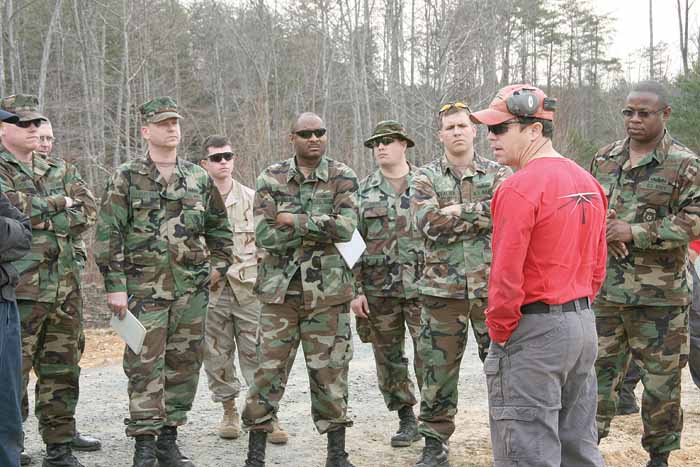
The Guide identifies much more than tactical and technical proficiency. In order to be awarded Navy Enlisted Classification Code 0814, Crew Served Weapon Instructor, each must conclusively demonstrate seven key attributes:
- Knowledge and Ability
- Self Control and Patience
- Communications Skills
- Ability to Inspire Confidence
- Positive Attitude and Enthusiasm
- Perception
- Open Mind
Producing large numbers of CSW Instructors with this combination of admirable traits isn’t easy. It begins with an individual’s personality profile – not everybody has a teaching temperament – and builds over four weeks of intense training.
The two-week Crew Served Weapons Operation and Maintenance course is a prerequisite for admission into the Instructor course. This provides a strong foundation in all mechanical aspects of the 7.62mm M60 and M240 series medium machine guns, the .50 caliber M2HB heavy machine gun, and the 40mm Mk 19 Mod 3 grenade machine gun.
The CSWI Course’s Program of Instruction (POI) is also two weeks long, beginning with general weapons and range safety, then marksmanship fundamentals, employment of CSWs, and planning for training.
Crawl, Walk, Run
Every task is outlined – broken down into logical steps called “teaching points” – and supported by clearly written documentation. We found superb narrative and graphic aids in the form of Information Sheets with reference materials from technical manuals, Diagram Sheets with simplified drawings showing mechanical principles, Job Sheets with step-by-step instructions, and the make or break Performance Tests.
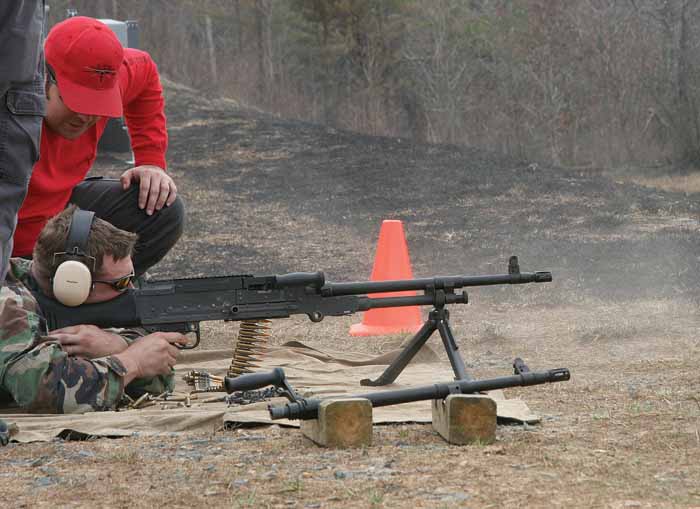
We were pleased to see that there is little if any “reinventing the wheel.” Marine Corps Weapons Publication 3-15.2.2 MACHINE GUNS AND GUNNERY, is the foundation for all of the CSWI POIs mechanical and practical application instruction. This superlative manual, in its umpteenth revision since the Marine bulldog was just a pup, is packed with no-nonsense information from real combat experience over the decades and can’t be improved upon
Indeed, Devil Dog machine gunners from World War One would find drawings in the new Navy manual illustrating fundamental Classes of Fire – Grazing, Plunging, Traverse, Search, Frontal, Flanking, Enfilade, and Oblique – nearly identical to those first used in instructional materials back in 1918 and carried forward in decades since.
Mastering Machine Guns
The thoroughness of instruction is immediately evident from a grouping of tasks for the veteran .50 caliber Browning M2HB machine gun. Ten detailed Job Sheets take the student through every aspect of this 90 year old favorite of GIs in all services. Affectionately known as “Ma Deuce,” this hard hitting and far-reaching combat weapon needs skilled attention for optimal performance.
So, the POI calls for mastery of stripping and assembly, cycle of operations, head space and timing, function check, load and unload both day and night, condition codes, trigger control and “rhythm,” malfunctions, and employment of the traversing and elevating mechanism.
Realistic training in several of these tasks once required going out to a live fire range, an expensive, time consuming process that is quickly degraded by inclement weather and many other factors. This enormous handicap is avoided in CSF’s CSWI training by extensive use of an elaborate FATS – Firearms Training System – installed at its compound in Chesapeake, Virginia.
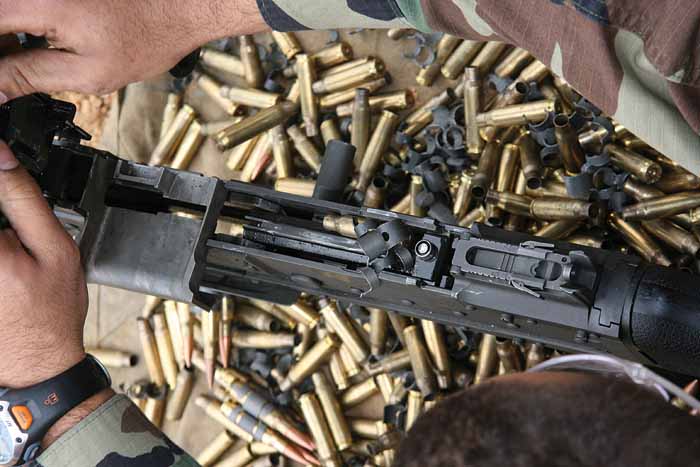
This sophisticated electro-optical-pneumatic system uses a powerful computer to digitally project different training scenarios on a big screen for “live fire” target engagement and scoring of hits. It uses specially modified actual weapons that load, fire, report, and recoil. While not a substitute for the course’s two days on an actual range, FATS is the next best thing, helping trainees work through problems in a controlled environment instead of wasting time and ammo.
Role Reversal
After demonstrating all of these to strict standards in classroom, simulator and live fire range qualification, each student must then take over the role of instructor. These three days in the second week are the hardest part for many of the students as they “teach back” all topics for each one of four very different machine gun systems. An extra degree of difficulty is provided by a cadre who likely take wicked pleasure in role-playing as slow learners or worse.
Again with an eye toward efficiency and practicality, blanks are used in teach-back for the actual firing tasks with each of the four machine guns. This has a number of positive aspects, not the least of which are safety and convenience.
During the teach-back ordeal, all seven key attributes of an effective instructor must be clearly shown in informal and formal evaluation. For example, if a hesitant or flustered instructor trainee fails to “inspire confidence,” he gets extra time and plenty of sympathetic remedial attention to get better. If that isn’t sufficient to correct the problem then the student will not graduate. Standards must be upheld.
Planning, Preparation and Documentation
The administration of machine gun training doesn’t have the excitement of putting rounds downrange but it is no less important to the big picture. The trainee CSWI learns range preparation, planning, setup, and management. Then, with so many Sailors needing periodic qualification and refresher training on machine guns, certification and documentation for their personnel records is also essential.
Are Your Good Enough?
The Crew Served Weapon Instructor Course is open to Sailors of all ratings in the rate of E5 and above. Detailed information may be found in CANTRAC, the Catalog of Navy Training Courses, at Navy Knowledge Online.

Find Out More
The Center for Security Forces provides training and human performance solutions to Navy Expeditionary, Security, and Antiterrorism professionals to meet the needs of the Fleet. CSF’s primary customers are personnel serving in the Master-at-Arms (MA) Rating, Sailors assigned in an antiterrorism role, the Navy Security Officer communities, and the Navy Expeditionary Combat Command (NECC). The Center trains Navy personnel worldwide in security and antiterrorism measures and procedures. CSF reports to the Naval Personnel Development Command (NPDC) and is part of the Naval Education and Training Command (NETC).
CSF website: www.npdc.navy.mil/csf
CFS News: www.news.navy.mil/local/csf/
NECC website: www.necc.navy.mil
US Navy: www.navy.mil
| This article first appeared in Small Arms Review V11N11 (August 2008) |












